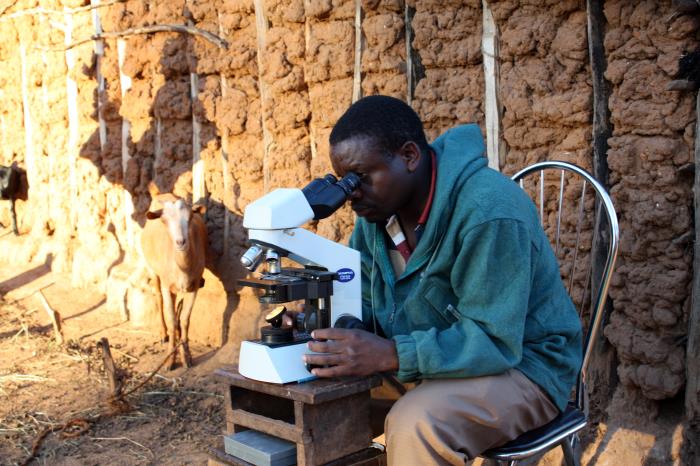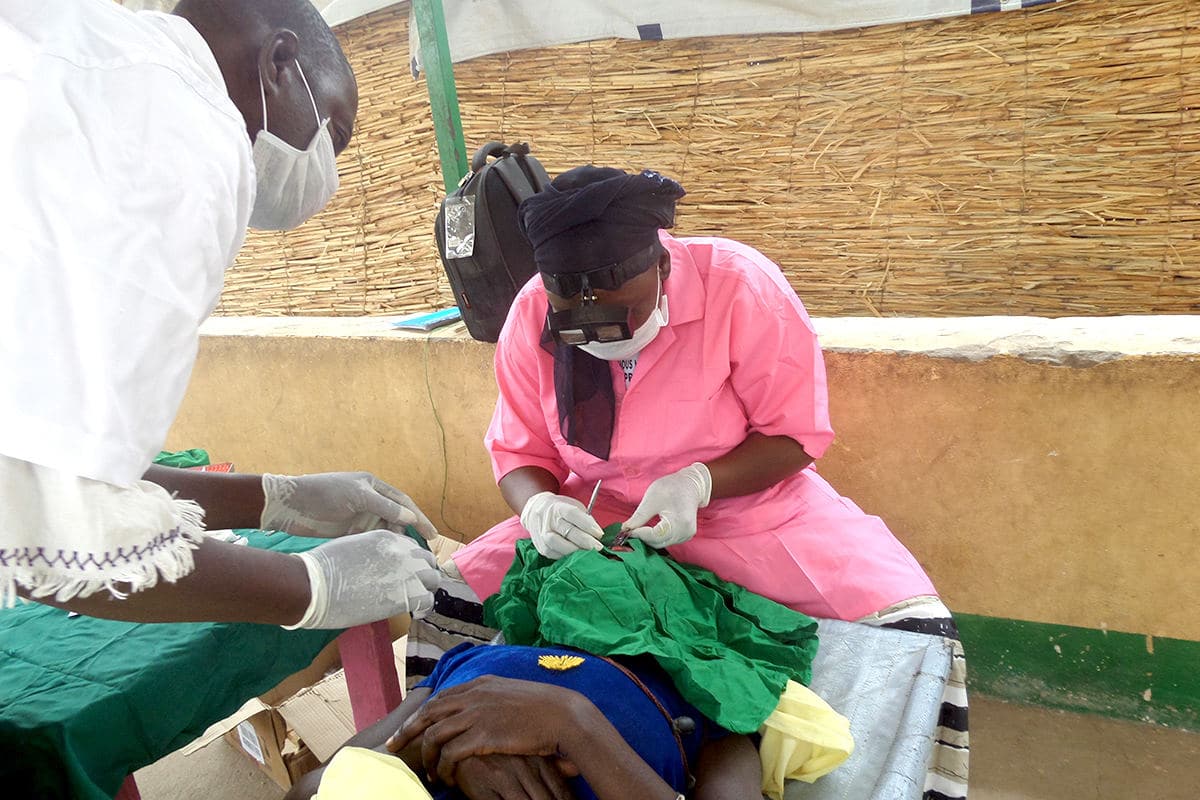The Organization for the Prevention of Blindness’ fight against blinding diseases and blindness
For over 40 years, OPC has provided local research, treatments and cures for people affected by blindness and blinding diseases, ensuring the human right to sight. Let’s break down the context and definitions of the blinding diseases OPC fights through its work.

Why focus on blinding diseases?
Blindness and vision impairment affect at least 2.2 billion people around the world, and about half have a preventable vision impairment or one that has yet to be addressed. Reduced eyesight or blindness can have major and long-lasting effects on all aspects of life, impacting interactions with the community, school, work and daily personal activities.
Millions of people are living with eye conditions that increase their risk of sight loss and blindness. According to the 2020 IAPB Global Impact Figures:
- 196 million people are living with age-related macular degeneration
- 146 million people are living with diabetic retinopathy
- 76 million people are living with glaucoma
- 2.5 million people are living with trachoma
- 277 million people are living with severe myopia
Because of demographic growth and aging populations, the blindness statistics are at risk of tripling and visual impairment is at risk of doubling by 2050. OPC is fighting so this does not happen, because sustainable solutions exist to preserve a person’s right to sight.
Who is affected by blinding diseases?

Vision loss can affect people of all ages, but the burden tends to be greater in rural areas and for people over 50 years old, women, people with disabilities, ethnic minorities, and indigenous populations. In low- and middle-income countries, blindness and vision loss are felt more deeply. In fact, the prevalence of vision impairment in these regions is estimated to be four times higher than in high-income regions.
On a regional level, Francophone Africa is frequently overlooked by international development stakeholders when it comes to restoring sight and providing quality eye care, so residents of Francophone African countries are particularly vulnerable.
What are the treatments for blinding diseases?
Treatments vary and depend on the cause and the extent of the vision loss. Surgery can remove cataracts and fix trachoma complications, while a simple pair of glasses can help uncorrected refractive errors.

OPC’s focus on 7 key eye diseases (blinding diseases)
OPC tackles the following blinding diseases in collaboration with national Ministries of Health and local organizations:
- Cataract. Cataract is an eye disease in which the lens of the eye becomes progressively opaquer, resulting in blurred vision. Causes include aging, cortisone medication, trauma, diabetes, and many others. Symptoms include pinpoint vision and a feeling of continual fog that can go as far as blindness. Cataract represents 34.47% of the causes of global blindness (all ages) and continues to be the leading cause of blindness in the world. Cataracts can be treated by surgery to remove the opaque lens and replace it with an artificial intraocular lens, with a high rate of success in restoring sight.
- Glaucoma. Glaucoma is a group of diseases that damage the eye’s optic nerve. This destruction process is characterized by an increase in eye pressure that often changes gradually and painlessly. Effective methods of treatment include medical and surgical treatment if the disease is diagnosed in its early stage. Through appropriate treatment, sight may be maintained. Untreated, it leads to the irreversible total loss of sight.
- Macular Degeneration. Macular degeneration, also known as Age-Related Macular Degeneration (AMD or ARMD), is an abnormality with an increase in eye pressure. Symptoms are characterized by a blurred or no vision at all in the center of the visual field due to the slow destruction of the optic nerve that can lead to the total loss of sight. The progression of the disease is painless and can be either very fast or very slow. At the moment there is no definitive treatment or cure of the disease; palliative treatments which are able to slow the progress of the disease include the use of drug injections, lasers, dynamic phototherapy and sometimes surgery.
- Diabetic Retinopathy. People with diabetes may develop an eye disease called diabetic retinopathy. This is when high blood sugar levels cause damage to blood vessels in the retina. These blood vessels can swell, leak or close, stopping blood from passing through. Symptoms include blurred or fluctuating vision, impaired color vision and dark or empty areas in the vision. Risk factors for diabetic retinopathy include duration of diabetes, level of glycemia, presence of high blood pressure, dependence on insulin, pregnancy, levels of selected serum lipids, nutritional and genetic factors. Medical intervention can decrease some of the risk to vision caused by diabetic retinopathy. The control of glycemia decreases the risk of occurrence and slows the progression of the retinopathy.
- Refractive Errors. Refractive errors include myopia (short-sightedness), hyperopia (far-sightedness) and astigmatism, which is when the front surface of the eye or the lens inside the eye is curved differently in one direction than the other. A common symptom of astigmatism is blurry vision. Refractive errors can be corrected with optical aids like eyeglasses.2.6 billion people have myopia, including 312 million children. This problem could be fixed with a simple, inexpensive pair of glasses. Learn about #Foresight, OPC’s school eye health program, which tackles this issue head-on.
- Trachoma. Trachoma is a painful disease caused by a bacterial infection of the eye. The bacterium Chlamydia trachomatis is commonly found in poor communities that have limited access to adequate sanitation and water. It is transmitted through contact with eye and nose discharge of infected people and is easily spread through contact with an infected person’s hands or clothes or spread by flies. Children are particularly at risk, as they spend the most time outside. If trachoma is left untreated, continued infection leads to the scarification of the eyelid, which causes the eyelashes to turn inward so they rub the surface of the eye, causing discomfort, pain and permanent damage to the cornea, which leads to irreversible blindness. The World Health Organization (WHO) recommended strategy to control trachoma is the SAFE strategy (Surgery, Antibiotics, Face washing and Environmental change), which consists of multiple interventions designed to reduce transmission, treat infection, and correct disease aftereffects.
- Onchocerciasis. Onchocerciasis (river blindness) is a parasitic disease endemic in 30 African countries. The disease is caused by a worm which is transmitted through the bites of infected blackflies. The blackflies are the vector that transmits the parasitic worm from human to human. Once transferred into the human body, the female adult worm produces thousands of baby worms (microfilariae) a day in the human body. These microfilariae move through the skin and eye causing damages such as skin rashes, lesions, itching, skin depigmentation and in the most serious cases, permanent blindness. The WHO recommended strategy for control of onchocerciasis is mass drug distribution.
Trachoma and onchocerciasis are also classified as Neglected Tropical Diseases (NTDs). Read our recent post about OPC’s fight against NTDs.
All seven of OPC’s blinding disease focus areas are categorized by the World Health Organization as priority eye diseases. OPC works with local governments, civil society organizations and communities to develop comprehensive eye care programs, expand access to sight-saving eye care services and encourage local ownership of eye health care systems.